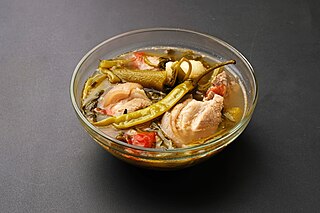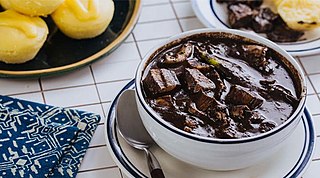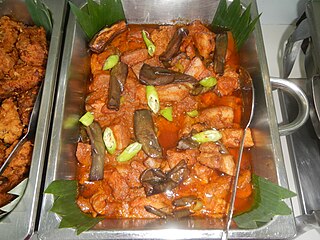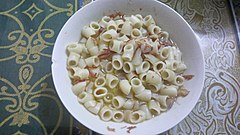
Chicken soup is a soup made from chicken, simmered in water, usually with various other ingredients. The classic chicken soup consists of a clear chicken broth, often with pieces of chicken or vegetables; common additions are pasta, noodles, dumplings, or carrots, and grains such as rice and barley. Chicken soup is commonly considered a comfort food.

Macaroni salad is a type of pasta salad, served cold, made with cooked elbow macaroni and usually prepared with mayonnaise. Much like potato salad or coleslaw in its use, it is often served as a side dish to barbecue, fried chicken, or other picnic style dishes. Like any dish, national and regional variations abound but generally it is prepared with raw diced onions, dill or sweet pickles and celery and seasoned with salt and pepper.

Sinigang is a Filipino soup or stew characterized by its sour and savory taste. It is most often associated with tamarind, although it can use other sour fruits and leaves as the souring agent such as unripe mangoes or rice vinegar. It is one of the more popular dishes in Filipino cuisine. This soup, like most Filipino dishes, is usually accompanied by rice.

Kare-kare is a Philippine stew that features a thick savory peanut sauce. It is generally made from a base of stewed oxtail, beef tripe, pork hocks, calves' feet, pig's feet or trotters, various cuts of pork, beef stew meat, and occasionally offal. Vegetables, such as eggplant, Chinese cabbage, or other greens, daikon, green beans, okra, and asparagus beans, are added. The stew is flavored with ground roasted peanuts or peanut butter, onions, and garlic. It is colored with annatto and can be thickened with toasted or plain ground rice. Variations of kare-kare can be made with seafood, such as prawns, squid, and mussels, or exclusively from vegetables.

Pancit, also spelled pansít, is a general term referring to various traditional noodle dishes in Filipino cuisine. There are numerous types of pancit, often named based on the noodles used, method of cooking, place of origin or the ingredients. Most pancit dishes are characteristically served with calamansi, which adds a citrusy flavor profile.

Noodle soup refers to a variety of soups with noodles and other ingredients served in a light broth. Noodle soup is a common dish across East Asia, Southeast Asia and the Himalayan states of South Asia. Various types of noodles are used, such as rice noodles, wheat noodles and egg noodles.

Sopa de mondongo is a soup that originally came from the Dominican Republic. It is made from diced tripe slow-cooked with vegetables such as bell peppers, onions, carrots, cabbage, celery, tomatoes, cilantro, garlic or root vegetables. The dish is generally prepared in former Spanish colonies in Latin America, Caribbean, and in the Philippines.

Picadillo is a traditional dish in many Latin American countries including Mexico and Cuba, as well as the Philippines. It is made with ground meat, tomatoes, and also raisins, olives, and other ingredients that vary by region. The name comes from the Spanish word picar, meaning "to mince".

Dinuguan is a Filipino savory stew usually of pork offal and/or meat simmered in a rich, spicy dark gravy of pig blood, garlic, chili, and vinegar.

Macaroni soup is soup that includes macaroni. The food is a traditional dish in Italy, and is sometimes served with beans, which is known as pasta e fagioli, and was also included in Mrs. Beeton's Book of Household Management, where the connection with Italy is mentioned and the dish includes Parmesan cheese. In the early 19th century, macaroni soup was one of the most common dishes in Italian inns.

Olivier salad is a traditional salad dish of Russian cuisine. Its creation is generally attributed to Lucien Olivier.

Nilaga is a traditional meat stew or soup from the Philippines, made with boiled beef or pork mixed with various vegetables. It is typically eaten with white rice and is served with soy sauce, patis, labuyo chilis, and calamansi on the side.

Afritada is a Philippine dish consisting of chicken, beef, or pork braised in tomato sauce with carrots, potatoes, and red and green bell peppers. It is served on white rice and is a common Filipino meal. It can also be cooked with seafood.

Paelya or paella (Spanish) is a Philippine rice dish adapted from the Valencian paella. However, it differs significantly in its use of native glutinous rice (malagkít), giving it a soft and sticky texture, unlike the al dente texture favoured in Spanish paella. It is also characteristically topped with sliced eggs. Filipino paelya does not use saffron, but is instead coloured with atsuete (anatto), luyang diláw (turmeric), or kasubhâ (safflower).

Filipino spaghetti is a Filipino adaptation of Italian spaghetti with Bolognese sauce. It has a distinctively sweet sauce, usually made from tomato sauce sweetened with brown sugar and banana ketchup. It is typically topped with sliced hot dogs or smoked longganisa sausages, giniling, and grated cheese. It is regarded as a comfort food in Philippine cuisine. It is typically served on almost any special occasion, especially on children's birthdays.

Binagoongan is a Filipino cooking process consisting of vegetables or meat sautéed or braised in bagoong alamang, garlic, black peppercorns, and bay leaves. Some recipes also add pineapples, chilis, or coconut cream to balance the flavors. The dish is characteristically quite salty with a strong umami flavor, which is why it is always paired with white rice and never eaten on its own. It is very similar to pinatisan which is cooked with patis, one of the by-products of fermenting bagoong.

Philippine asado refers to two different Filipino braised meat dishes. The name originates from Spanish asado ("grilled"), a reference to the original dish it was applied to, the Chinese-Filipino version of char siu barbecues usually known as pork asado. However, the Filipino versions have evolved to be braised, not grilled. The other Filipino dishes also known as asado are asado de carajay and asado matua. Unlike the Chinese-derived version, they are savory rather than sweet.

Indonesian noodles are a significant aspect of Indonesian cuisine which is itself very diverse. Indonesian cuisine recognizes many types of noodles, with each region of the country often developing its own distinct recipes.

Carne norte guisado, also known as corned beef guisado, is a Filipino dish made from shredded canned corned beef sautéed with onion rings. It's a very simple dish and is popularly eaten for breakfast with white rice or pandesal. Finely diced potatoes, carrots, scallions, tomatoes, cabbage, bell pepper, and garlic may also be added. A notable variant of the dish is sinabawang corned beef, which just adds beef stock or water to the dish after sautéing, making it soupier.






















